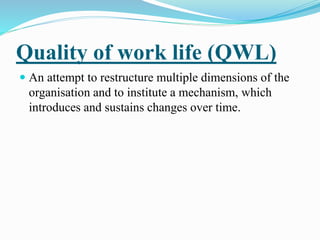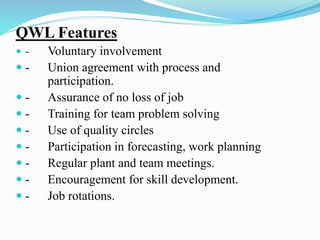Structural Interventions
- 1. ORGANISATION CULTURE AND DEVELOPMENT IN STRUCTURAL INTERVENTION By K.VINOTH KUMAR
- 2. Structural Interventions May be called as techno structural interventions This class of interventions include changes in how the overall work of an organization is divided into units, who reports to whom, methods of control, the arrangement of equipment and people, work flow arrangements and changes in communications and authority.
- 3. Sociotechnical System(STS) It is largely associated with experiments attempted to create better fit among the technology, structure and social interactions of a particular production unit. Characteristics of Sociotechnical System (1) Effective work system must jointly optimize the relationship between their social and technical parts. (2) The creation and development is an important factor in STS implementation. The implementation of STS should be highly participative
- 4. Self managed teams The team is autonomous and its members are responsible to no one but each other. The team’s effort is based on team’s result and not on the performance of its members. Individual performance is an internal team issue. A self-managed team is not just a group of people working together but also a genuine collaboration. It is measured by its results, not the performance of its individual member. Self-managed teams: Are more independent than other types of team. Delegation to the team many information of how the works gets done Should set their targets. Should be fully empowered
- 5. Work Redesign (Richard Hackman & Greg Oldham) OD approach to work redesign based on a theoretical model of what job characteristics lead to the psychological states that produce what they call "higher internal work motivation." According Hackman and Oldham organization analyses jobs using the five core job characteristics - i.e. skill variety, task identity, task significance, autonomy and feedback from the job.
- 7. Quality of work life (QWL) An attempt to restructure multiple dimensions of the organisation and to institute a mechanism, which introduces and sustains changes over time.
- 8. QWL Features - Voluntary involvement - Union agreement with process and participation. - Assurance of no loss of job - Training for team problem solving - Use of quality circles - Participation in forecasting, work planning - Regular plant and team meetings. - Encouragement for skill development. - Job rotations.
- 9. Conclusion These features include union involvement - a focus on work teams, problem solving session by the work teams in which the agenda may include productivity, quality and safety problems, autonomy in planning work the availability of skill training and increased responsiveness to employees by supervision.









